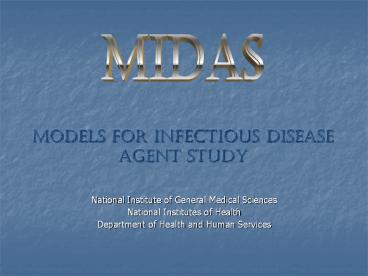Models for Infectious Disease Agent Study - PowerPoint PPT Presentation
1 / 22
Title:
Models for Infectious Disease Agent Study
Description:
What is the Steering Committee Going to Do Anyway? NIH Biodefense. Concerns ... 5 Cooperative Centers for Translational Research on Human Immunology and Biodefense ... – PowerPoint PPT presentation
Number of Views:64
Avg rating:3.0/5.0
Title: Models for Infectious Disease Agent Study
1
Models for Infectious Disease Agent Study
MIDAS
- National Institute of General Medical Sciences
- National Institutes of Health
- Department of Health and Human Services
2
Agenda
- NIH Context
- Purpose
- Organization of MIDAS
- Roles of Participants
- What is the Steering Committee Going to Do
Anyway?
3
NIH Biodefense
Involves all Institutes and Centers
- Concerns
- Biological / Infectious Agents and Toxins
- Chemical Agents
- Nuclear and Radiological Agents
- Mental and Behavioral Health
- Focuses on
- Basic Research
- Diagnosis
- Intervention
- Education and Training
4
NIAID - 1.6 billion
- 8 Regional Centers of Excellence
- 11 National and Regional Biocontainment Labs
- 5 Cooperative Centers for Translational Research
on Human Immunology and Biodefense
- Research on Category A microbes
- Genomic sequencing
- Vaccine Development
- Drug Development
- Diagnostics
5
Other Institutes
- Genomics and Proteomics
- NHGRI, NLM, NIGMS NIAID,
- Informatics
- NLM, NCI, NIGMS, NIAID
- Diagnostics and Imaging
- NIBIB, NCRR, NIDND, NIDCR
- Clinical Resources
- NCRR, NIGMS, NHLBI, various population resources
- Modeling
- NIGMS
6
will consist of an informatics center and network
of multidisciplinary scientists conducting
computational and mathematical research to
improve the ability to detect, control, and
prevent emerging infectious diseases
MIDAS
7
Purpose of MIDAS
- Improve the nations ability to respond to
biological threats promptly and effectively by - Developing useful computational tools and models
of emerging infectious diseases - Building models in response to real or
anticipated outbreaks - Making tools and models available to
policymakers, public health professionals, and
researchers
8
Principles
- Partnership between NIH and scientific community
- Pilot program opportunity to redesign
- Multidisciplinary
- Small interacting research groups
- Sophisticated informatics group
- Many opportunities for interaction and sharing
9
A Word About Data
- MIDAS does not fund primary laboratory or
clinical research - MIDAS does support research using existing
information, datasets, or simulated data - It is a requirement that all data be deposited in
the Informatics Center - It is a requirement that all products be
deposited and made available
10
Scientific Themes
11
Scientific Objectives
- Development, validation, and implementation of
models for - Transmission of bioterrorism agents or naturally
occurring infectious diseases - Release, spread, and detection of
naturally-occurring and bioterrorist agents - Differential diagnosis of natural outbreaks and
bioterrorist attacks
12
Scientific Objectives
- Development, validation, and implementation of
models for - Distribution and allocation of resources in
response to an outbreak - Evaluation of the long-term consequences of
response strategies - Effects and efficacy of interventions
13
In Case Of Emergency
- NIGMS may redirect the MIDAS network to conduct
research related to scenarios, policy decisions,
or events involving an emerging outbreak. - The Steering Committee will be involved in
constructing the appropriate questions and making
recommendations to NIGMS.
14
Organization of MIDAS
15
Cooperative Agreement (U01)
Research Scientist
NIH/NIGMS
Scientist has primary leadership and authority to
manage project. NIH acts as a partner and has
considerable involvement in setting directions
and priorities.
16
MIDAS
Research Group Emory University
Research Group Johns Hopkins University
Informatics Group RTI
Research Group Los Alamos National Labs
17
MIDAS
NIGMS Council and Advisory Group
MIDAS Steering Committee
MIDAS Network Research Groups Informatics Group
NIGMS
18
Research Groups
- Will conceive, develop, and conduct research
relevant to developing mathematical and
computational models of emerging infectious
diseases - Must identify data liaison person to interact
with Informatics Group - Must use standard exchange protocols
- Must comply with intellectual property agreement
19
Informatics Group
- Will construct and implement a database and
interface for MIDAS information and tools - Will monitor data for quality, accuracy,
completeness, and non-redundancy - Will facilitate comprehensive sharing of data,
models, and tools - Will generate simulated data
- Will test and validate models
20
NIGMS Council Advisory Group
- Advises NIGMS on overall program direction and
progress
21
Steering Committee
- Is the main governing body
- Consists of program directors of the informatics
and research groups, NIH staff, and outside
consultants - Develops and oversees policy
- Sets milestones for the Network
- Sets standards for information management
- Alerts NIGMS to scientific opportunities,
emerging needs, and impediments - Considers the views of other researchers
- Establishes subgroups as needed
22
Monitoring
- The Network will meet monthly by conference call
- The Steering Committee will meet at least
annually - Additional meetings can be added as needed.

